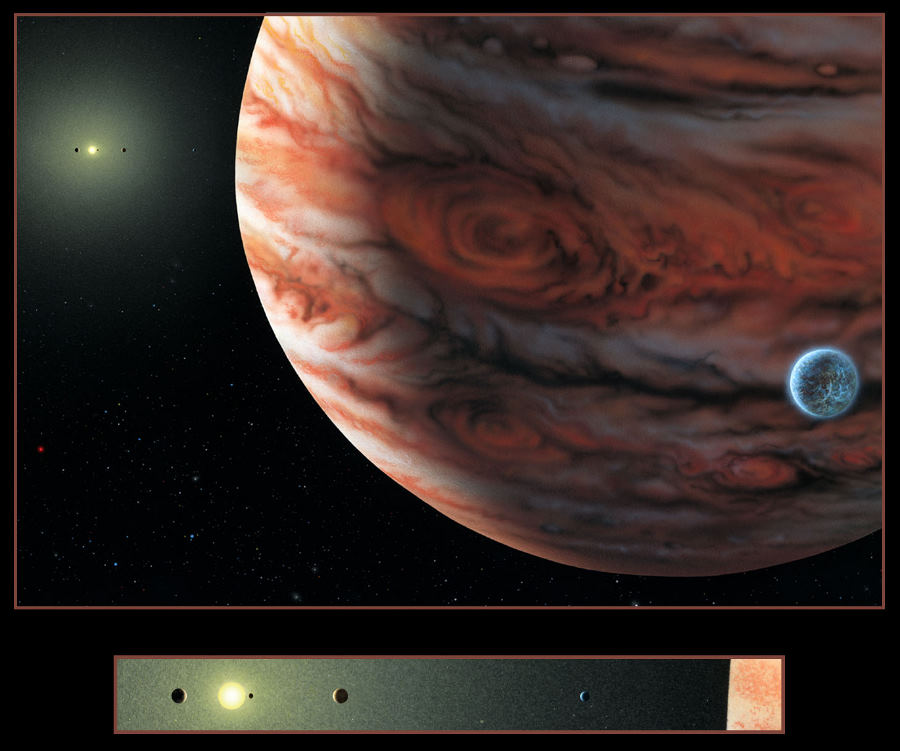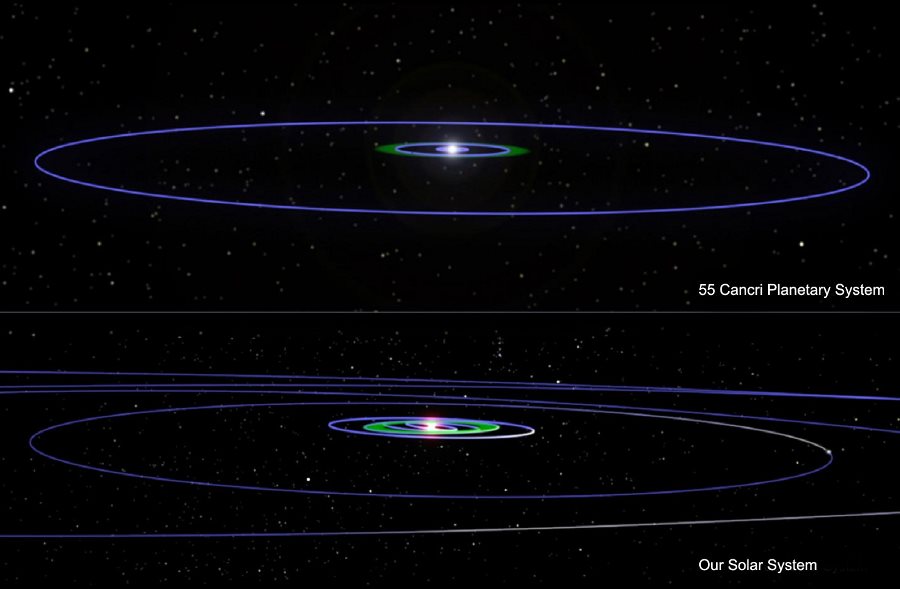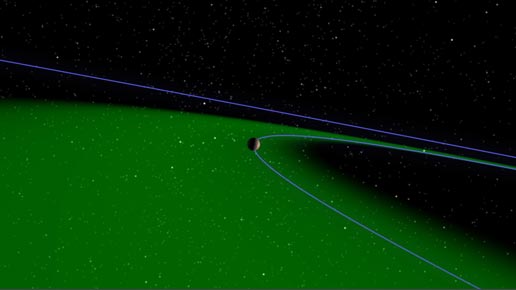|
Extra Solar Planets New Planets Discovered |
|
|
The First Five-Planet System .
NASA Press Release
|
|
Full image and caption - - Related animation This artist's concept shows four of the five planets that orbit 55 Cancri, a star much like our own. The most recently discovered planet, and the fourth out from the star, looms large in the foreground. It is at least 45 times the mass of Earth, or half the mass of Saturn, and it orbits the star every 260 days. The system's three known inner planets can be seen in the background around the glowing star, while its most distant planet is not pictured. Fifty-five Cancri has produced a larger number of massive planets than our solar system. The colors of the planets in this illustration were chosen to resemble those of our own solar system. Astronomers do not know what the planets look like. 11.06.07 PASADENA,
Calif. - Astronomers have announced the
discovery
of a fifth planet circling 55 Cancri, a star
beyond our solar system. The
star now holds the record for number of
confirmed extrasolar planets orbiting
in a planetary system.
55 Cancri is located 41 light-years away in the constellation Cancer and has nearly the same mass and age as our sun. It is easily visible with binoculars. Researchers discovered the fifth planet using the Doppler technique, in which a planet's gravitational tug is detected by the wobble it produces in the parent star. NASA and the National Science Foundation funded the research. "It is amazing to see our ability to detect extrasolar planets growing," said Alan Stern, associate administrator for the Science Mission Directorate at NASA Headquarters, Washington. "We are finding solar systems with a richness of planets and a variety of planetary types comparable to our own." The newly discovered planet weighs about 45 times the mass of Earth and may be similar to Saturn in its composition and appearance. The planet is the fourth from 55 Cancri and completes one orbit every 260 days. Its location places the planet in the "habitable zone," a band around the star where the temperature would permit liquid water to pool on solid surfaces. The distance from its star is approximately 116.7 million kilometers (72.5 million miles), slightly closer than Earth to our sun, but it orbits a star that is slightly fainter. SOURCE: NASA |
|
|
This artist's concept illustrates
two planetary systems - 55 Cancri (top) and our
own. Blue lines show the
orbits of planets, including the dwarf planet
Pluto in our solar system.
The 55 Cancri system is currently the closest
known analogue to our solar
system, yet there are some fundamental
differences.
The similarities begin with the stars themselves, which are about the same mass and age. Both stars also host big families of planets. Our solar system has eight planets, while 55 Cancri has five, making it the record-holder for having the most known exoplanets. In fact, 55 Cancri could have additional planets, possibly even rocky ones that are too small to be seen with current technologies. All of the planets in the two systems have nearly circular orbits. In addition, both planetary systems have giant planets in their outer regions. The giant located far away from 55 Cancri is four times the mass of our Jupiter, and completes one orbit every 14 years at a distance of five times that between Earth and the sun (about 868 million kilometers or 539 million miles). Our Jupiter completes one orbit around the sun every 11.9 years, also at about five times the Earth-sun distance (778 million kilometers or 483 million miles). Fifty-five Cancri is still the only known star besides ours with a planet in a distant Jupiter-like orbit. Both systems also contain inner planets that are less massive than their outer planets. The differences begin with the planets' masses. The planets orbiting 55 Cancri are all larger than Earth, and represent a "souped-up" version of our own solar system. In fact, this is the first star that boasts more giant planets than our sun! The arrangement of the planetary systems is also different. The inner four planets of 55 Cancri are all closer to the star than Earth is to the sun. The closest, about the mass of Uranus, whips around the star in just under three days at a distance of approximately 5.6 million kilometers (3.5 million miles). The second planet out from the star is a little smaller than Jupiter and completes one orbit every 14.7 days at a distance of approximately 17.9 million kilometers (11.2 million miles). The third planet out from the star is similar in mass to Saturn and completes one orbit every 44 days at a distance of approximately 35.9 million kilometers (22.3 million miles). The fourth planet is about half the mass of Saturn, orbits every 260 days and is approximately 116.7 million kilometers (72.5 million miles) away from the star. SOURCE: NASA |
|
|
"The gas-giant
planets in our solar system all have
large moons," said Debra Fischer, an astronomer at
San Francisco State
University and lead author of a paper that will
appear in a future issue
of the Astrophysical Journal. "If there is a moon
orbiting this new, massive
planet, it might have pools of liquid water on a
rocky surface."
Fischer and University of California, Berkeley, astronomer Geoff Marcy, plus a team of collaborators discovered this planet after careful observation of 2,000 nearby stars with the Shane telescope at Lick Observatory located on Mt. Hamilton, east of San Jose, Calif., and the W.M. Keck Observatory in Mauna Kea, Hawaii. More than 320 velocity measurements were required to disentangle signals from each of the planets. "This is the first quintuple-planet system," said Fischer. "This system has a dominant gas giant planet in an orbit similar to our Jupiter. Like the planets orbiting our sun, most of these planets reside in nearly circular orbits." "Discovering these five planets took us 18 years of continuous observations at Lick Observatory, starting before any extrasolar planets were known anywhere in the universe," said Marcy, who contributed to the paper. "But finding five extrasolar planets orbiting a star is only one small step. Earth-like planets are the next destination." The planets around 55 Cancri are somewhat different from those orbiting our sun. The innermost planet is believed to be about the size of Neptune and whips around the star in less than three days at a distance from the star of approximately 5.6 million kilometers (3.5 million miles). The second planet is a little smaller than Jupiter and completes one orbit every 14.7 days at a distance from the star of approximately 18 million kilometers (11.2 million miles). The third planet, similar in mass to Saturn, completes one orbit every 44 days at a distance from the star of approximately 35.9 million kilometers (22.3 million miles). The newly discovered planet is the fourth planet. The fifth and most distant known planet is four times the mass of Jupiter and completes one orbit every 14 years at a distance from the star of approximately 867.6 million kilometers (539.1 million miles). It is still the only known Jupiter-like gas giant to reside as far away from its star as our own Jupiter is from our sun. "This work marks an exciting next step in the search for worlds like our own," said Michael Briley, an astronomer at the National Science Foundation. "To go from the first detections of planets around sun-like stars to finding a full-fledged solar system with a planet in a habitable zone in just 12 years is an amazing accomplishment and a testament to the years of hard work put in by these investigators." For visuals depicting the new
planets on the Web, visit:
For information about NASA and
agency programs, visit:
Media contacts: DC Agle 818-393-9011
Grey Hautaluoma 202-358-0668
Denize Springer 415-405-3803
Bob Sanders 510-643-6998
2007-128 SOURCE: NASA |
|
|
This artist's animation takes us on a journey to 55 Cancri, a star with a family of five known planets - the most planets discovered so far around a star besides our own. The animation begins on Earth, with a view of the night sky and 55 Cancri (flashing dot), located 41 light-years away in the constellation Cancer. It then zooms through our solar system, passing our asteroids and planets, until finally arriving at the outskirts of 55 Cancri. The first planet to appear is the farthest out from the star – a giant planet, probably made of gas, with a mass four times that of Jupiter. This planet orbits its star every 14 years, similar to Jupiter's 11.9-year orbit. As the movie continues, the three inner planets are shown, the closest of which is about 10 to 13 times the mass of Earth with an orbital period of less than three days. Zooming out, the animation highlights the newest member of the 55 Cancri family – a massive planet, likely made of gas, water and rock, about 45 times the mass of Earth and orbiting the star every 260 days. This planet is the fourth out from the star, and lies in the system's habitable zone (green). A habitable zone is the place around a star where liquid water would persist. Though the newest planet probably has a thick gaseous envelope, astronomers speculate that it could have one or more moons. In our own solar system, moons are common, so it seems likely that they also orbit planets in other solar systems. If such moons do exist, and if they are as large as Mars or Earth, astronomers speculate that they would retain atmospheres and surface liquid water that might make interesting environments for the development of life. The animation ends with a comparison between 55 Cancri and our solar system. The colors of the illustrated planets were chosen to resemble those of our own solar system. Astronomers do not know what the planets look like. SOURCE: NASA |
|
| FAIR USE NOTICE: This page contains copyrighted material the use of which has not been specifically authorized by the copyright owner. Pegasus Research Consortium distributes this material without profit to those who have expressed a prior interest in receiving the included information for research and educational purposes. We believe this constitutes a fair use of any such copyrighted material as provided for in 17 U.S.C § 107. If you wish to use copyrighted material from this site for purposes of your own that go beyond fair use, you must obtain permission from the copyright owner. | |
|
|




